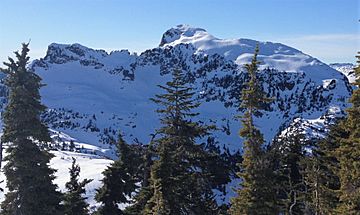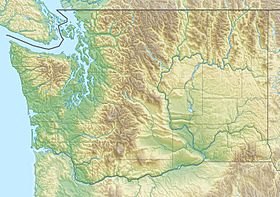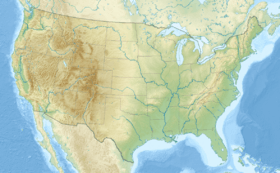Iron Cap Mountain facts for kids
Quick facts for kids Iron Cap Mountain |
|
|---|---|

Northeast aspect seen in winter
|
|
| Highest point | |
| Elevation | 6,347 ft (1,935 m) |
| Prominence | 787 ft (240 m) |
| Isolation | 1.74 mi (2.80 km) |
| Parent peak | Big Snow Mountain (6,680 ft) |
| Geography | |
| Location | Alpine Lakes Wilderness King County, Washington state, U.S. |
| Parent range | Cascade Range |
| Topo map | USGS Big Snow Mountain |
| Climbing | |
| First ascent | 1925 Joe Hazard and party |
| Easiest route | class 2-3 scrambling North Ridge |
Iron Cap Mountain is a mountain peak in Washington state, U.S. It stands about 6,347-foot (1,935-metre) tall. You can find it in King County, near the Cascade Range. This mountain is part of the beautiful Alpine Lakes Wilderness. It is managed by the Mount Baker-Snoqualmie National Forest.
Water from the mountain's south side flows into the Snoqualmie River. Water from the north side goes into the Foss River. Even though Iron Cap Mountain isn't the tallest, it rises sharply. It climbs 2,500 feet from the valley floor in less than a mile! Nearby peaks include La Bohn Peak and Little Big Chief Mountain.
Contents
Understanding Iron Cap Mountain's Climate
Iron Cap Mountain has a marine west coast climate. This means it gets a lot of moisture from the Pacific Ocean. Weather systems often move northeast towards the Cascade Mountains. When these systems hit the mountains, the air is forced upwards. This process is called Orographic lift. It causes the air to cool and drop its moisture as rain or snow.
Winter Weather and Snowfall
The west side of the Cascades gets a lot of rain and snow. Winter months bring heavy snowfall. Because of the ocean's influence, the snow is often wet and heavy. This can create a danger of avalanches. You might even see small patches of ice on the mountain's east and northwest sides.
Summer Weather and Best Visiting Times
During winter, the weather is usually cloudy. But in summer, high-pressure systems over the Pacific Ocean bring clear skies. This means less cloud cover. The best time to visit or climb Iron Cap Mountain is from July through September. The weather is usually clear and sunny then.
How Iron Cap Mountain Was Formed: Geology
The Alpine Lakes Wilderness is known for its rugged landscape. It has jagged peaks, deep valleys carved by glaciers, and granite cliffs. There are also more than 700 mountain lakes! The amazing landscape and different climates here were created by geological events long ago.
Ancient Earth Movements and Volcanoes
The Cascade Range began forming millions of years ago. This happened during the late Eocene Epoch. The North American Plate slowly moved over the Pacific Plate. This caused volcanic activity. Also, pieces of the Earth's crust, called terranes, helped form the North Cascades about 50 million years ago.
The Impact of Glaciers
Over two million years ago, during the Pleistocene period, glaciers covered the land. They moved forward and backward many times. As they moved, they scraped and shaped the landscape. They left behind rock debris. The last glaciers in the Alpine Lakes area started to melt about 14,000 years ago. They were gone from the region by 10,000 years ago.
The U-shaped valleys you see today were carved by these glaciers. The combination of land uplift, faulting (where the Earth's crust breaks), and glaciation created the tall peaks and deep valleys of the Alpine Lakes Wilderness.



